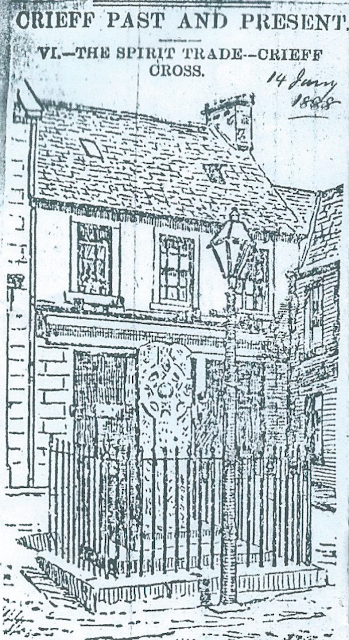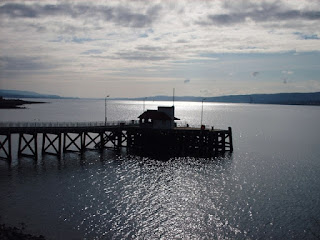- Get link
- X
- Other Apps
Posts
Showing posts from 2017
Crieff Past and Present : The Cross of Crieff and Drummond Cross 14 January 1888
- Get link
- X
- Other Apps

About forty years ago, a neighbouring distiller allowed information to reach the ears of the Excise that a number of respectable people in the Town had obtained smuggled spirits though his servants. A little panic was caused, and the books of the establishment were placed in the hands of the local Sheriff – Clerk’s hands .Next morning placards were posted over the town offering a reward of £50 to any person who would give information as to who broke into the Sheriff- Clerk’s Office and stole the Distillery books. The knowing ones did not hesitate to say that the books would never turn up. It was surmised that they were burned .The carters of the distillery also disappeared, and the case went no further. The Cross of Crieff stands between High Street and East High Street, and was for long the market place where farmers and their wives appeared each week to dispose of their butter, cheese and eggs and tradesmen and butchers retailed their wares. The Cross Stone is said to ha...
St Fillan Historic Scenes of Perthshire
- Get link
- X
- Other Apps

St Fillan Historic Scenes of Perthshire by The Rev William Marshall (1880) As we approach Loch Earn, we come to a scene consecrated by its connection with the famous St Fillan, who evangelised the country here and in the wilds of Breadalbane, and whose arm did such wonders on the field of Bannockburn. The beautiful hill covered with verdure to the top, and the green of which contrasts so strikingly with the brown and the grey of the adjacent heights, is Dunfillan, the hill of St Fillan. The rock on the top of it was the Saint’s Chair. The spring, now days at the foot of the it, was the Saint’s Well. It was originally on the top of the hill; but, disgusted with the Reformation from P...
- Get link
- X
- Other Apps

College House Crieff ( A letter written to the Strathearn Herald by Frederika Constance Cummings on September 6 th 1918 ) Introduction Constance Frederica “Eka” Gordon-Cumming (26 May 1837 – 4 September 1924) was a travel writer and painter. She was born on 26 May 1837 at Altyre, near Forres in Scotland , the 12th child of a wealthy family. Her parents were Sir William Gordon-Cumming, 2nd Baronet , and Elizabeth Maria (Campbell) Cumming. She was the aunt of Sir William Gordon-Cumming, 4th Baronet . She grew up in Northumberland , and was educated at Fulham , London. She taught herself how to paint, and had help from artists visiting her home, including one of Queen Victoria 's favorite painters, Sir Edwin Landseer . After spending a year in India in 1867 and writing in In the Himalayas and on the Indian Plains (1884) [1] she became interested in travel. Gordon-Cumming was a prolific travel writer and landscape painter who ...
- Get link
- X
- Other Apps
Sir , When writing my autobiography , I gave a brief account of the remarkable variety of changes through which this quaint house has passed . Though its probable age is probably not more than 150 years and its situation at the top of the High Street must have kept it always prominent in the annals of Crieff , I have been surprised at the difficulty in obtaining accurate information concerning its many transformations . To begin with , I was assured on apparently excellent , that Dr Malcolm , the original builder , was a medical man , and that his object was to found a Medical College .I know that he was an LL.D and was for many years the school master at Madderty . He built this house as a Boarding School for Boys . He was a student of Persian and wrote several books . He made the first survey of Crieff which is now at Dollerie . After his death , the side wings of the College were tenanted by sixteen families almost all handloom weavers ( of whom upwards ...
- Get link
- X
- Other Apps

William Smeaton A Crieff Worthy of Yesteryear ( Macara 1881) William Smeaton was well known in his day as a keen angler, and his narrative powers were of a high order. This latter was generally used to recount the deeds of the former, which were at times extraordinary. He lived in North Bridgend near the River Earn, and had ample scope to improve his talents. He could dress a good fly hook, and while at work, with a good listener beside him, his hands and eloquence would work at high pressure. He assured his hearers that he best way to make sure of having the proper fly for a particular stream was to go to the stream , catch a specimen of the water flies in the locality , dress a hook to the pattern, and , to make an assurance doubly sure, fix the newly made hook to the line and hang it so as to touch the water, strip yourself , and after plunging into the water , look up through the liquid element and judge of your ...
More Tales of Inchaffray Abbey in Madderty
- Get link
- X
- Other Apps

Inchaffray Abbey in Madderty I have written more than a few lines over the years ( including a few blogs ) on this much neglected and significant part of our ancient heritage . Since the Reformation it has suffered neglect and much of its fabric has been plundered to provide amongst other things hewn stone for houses , farms and indeed the " new " church built in the 17th century a short distance away. The insensitivity of the Local Authority to allow the building of a modern dwelling cheek by jowl was inexcusable and questionable . Having had yet another rant let me highlight a couple of wee tales concerning Inchaffray . These indeed were ably covered by the late Bessy MacLagan in her classic book on Madderty published in 1932 and although out of print since before the War , can be borrowed from the Strathearn Campus Library in Crie...
